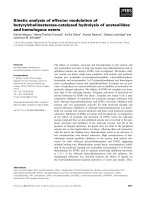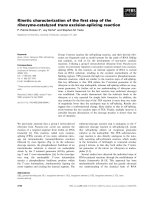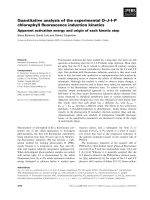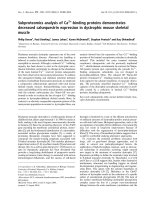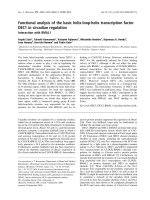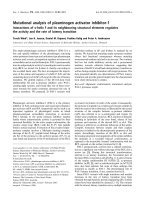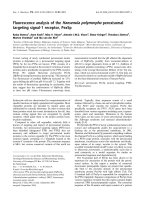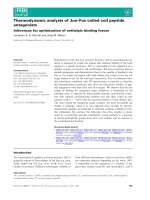Báo cáo khoa học: Kinetic analysis of zymogen autoactivation in the presence of a reversible inhibitor pptx
Bạn đang xem bản rút gọn của tài liệu. Xem và tải ngay bản đầy đủ của tài liệu tại đây (223.15 KB, 8 trang )
Kinetic analysis of zymogen autoactivation in the presence
of a reversible inhibitor
Wei-Ning Wang, Xian-Ming Pan and Zhi-Xin Wang
National Laboratory of Biomacromolecules, Institute of Biophysics, Academia Sinica Beijing, P.R. China
Limited p roteolysis is a highly specific irreversible process,
which can serve to initiate physiological function by con-
verting a precursor protein into a b iologically active form.
When the activating e nzyme and the ac tivated enzyme
coincide, t he process i s an a utocatalytic zymogen activation
(i.e. r eactions in which t he zymogens serves as a substrate f or
the c orresponding active enzyme). The a ctivity of p roteases
is frequently regulated by the binding of specific protease
inhibitors. Thus, to understand the biological regulation
of proteo lysis, one must understand the role of protease
inhibitors. In the present study, a detailed kinetic analysis of
autocatalytic reaction modulated by a reversible inhibitor is
represented. On the basis of the kinetic equation, a novel
procedure is developed to evaluate the kinetic parameters of
the reaction. As an example of the application of this
method, effects of acetamidine, p-amidinobenzamidine a nd
benzamidine o n t he autoactivation of trypsinogen by trypsin
were studied.
Keywords: limited proteolysis; reversible inhibition; trypsin;
trypsinogen; z ymogen activation.
Proteolysis is required for a multitude of developmental a nd
physiologic events including digestion, metabolism, differ-
entiation, immunity, blood coagulation, fibrinolysis, apop-
tosis and response to injury [ 1–9]. The e n zymes responsible
for the catalysis o f proteolysis are p roteases. During the last
century, the number of known enzymes that demonstrate
proteolytic a ctivity has increases exponentially an d we h ave
an increased understanding of the mechanisms and c ritical
roles that proteases play in physiological and pathological
processes. Proteases are normally biosynthesized as some-
what larger inactive precursors. These precursors are
known as zymogens (enzyme precursors, in general, are
known a s proenzymes). T he zymogens must undergo an
activation process, usually a limited proteolysis, to attain
their catalytic activity at a physiologically appropriate time
and p lace. Small peptides are cleaved from zymogens to
form the active proteases. T he active forms of zymogens
usually have powerful physiological effects, an d their
synthesis in an inactive form permits them to be safely
stored until they are required [1]. When the activating
enzyme and the activated enzyme coincide, the process is an
autocatalytic zymogen activation. Physiological examples
of these processes are the activation of trypsinogen,
prekallikrein, pepsinogen, procathepsin B and human
blood coagulation factor XII by their active forms of
enzymes, respectively [1,10–13].
Limited proteolysis is a highly specific irreversible
process, which can serve to initiate physiological function
by converting a precursor protein into a biologically active
form. The conversion of a zymogen into a protease by
cleavage of a single peptide bond is a p recise means of
switching on enz yme activity. As this type of activation is
irreversible, different mechanisms are needed to prevent
proteolysis. Specific protease inhibitors accomplish th is
task. T he activity of proteases can be inhibited by the
binding of specific protease inhibitors. Both proteolytic
enzymes and protease inhibitors are prevalent in all
biological tissues and fluids. N early every protease is faced
with an antagonist limiting its proteolytic a ctivity locally
and in a timely fashion to prevent pathologies. Therefore,
the activity of a proteolytic enzyme in a living organism is
regulated by synthesis and secretion of the enzyme, by
zymogen a ctivation and f requently by inhibit ion [14–16]. In
addition, major reasons for proteolysis-induced pathologies
are either excessive production of liberation (e.g. from cells
and microbes) of proteases o r extensive consumption o f
protease inhibitors or both, leading to an imbalance of
the physiological protease/inhibitor equilibrium. Therefore,
protease inhibitors are promising candidates for new
therapeutic approaches based on the basic pathomecha-
nisms of these diseases. Thus, t o understand t he biological
regulation of proteolysis, one must understand the role o f
endogenous and exogenous protease inhibitors [17–20].
Recently, detailed kinetic studies of the autoactivation o f
protein kinase and zymogen h ave been reported [21–23]. I n
the present communication, a global kinetic analysis of
zymogen autoactivation regulated by a reversible inhibitor
is represented. As an example of the application of this
method, effec ts of acetamidine, p-amidinobenzamidine and
benzamidine o n t he autoactivation of t rypsinogen by
trypsin were analyzed.
Correspondence to Z X. Wang, National Laboratory of Biomacro-
molecules, Institute of Biophysics, Academia Sinica Beijing 1 00101,
P.R. China. Fax: +86 10 64872026, E-mail: zx
Abbreviations: DFP, diisopropylfluorophosphate; TAME,
N-a-p-tosyl-
L
-arginine methyl ester.
(Received 7 September 2004, acc epted 5 Oc tober 2004)
Eur. J. Biochem. 271, 4638–4645 (2004) Ó FEBS 2004 doi:10.1111/j.1432-1033.2004.04416.x
Theoretical analysis
In the case of the autocatalytic reactions, the zymogen
serves as a substrate in reactions. The general mechanism
of the autocatalytic reaction o f an enzyme in the presence
of a reversible inhibitor can be written as shown in
Scheme 1:
where W is the p eptid e which is e liminated from Z,andI, E
and Z represent inhibitor, enzyme and zymogen, respect-
ively. In this mech anism, both enzyme E and enzyme–
zymogen complex EZ combine with i nhibitor I,butthe
enzyme–inhibitor–substrate c omplex does not proceed to
form product. As the concentrations of zymo gen and
enzyme are of the same order of magnitude, the steady-state
assumption is not satisfactory in this case [24]. W hen t here is
rapid equilibrium as far a s EI, EZ and EIZ are concerned,
i.e. when k
2
is sufficiently small as not to disturb equilib-
rium, we then have
K
S
¼
½E½Z
½EZ
; K
0
S
¼
½E½EI
½EIZ
K
I
¼
½E½I
½EI
; K
0
I
¼
½EZ½I
½EIZ
ð1Þ
The total concentration of enzyme is
½T
0
¼½E
0
þ½Z
0
¼½Eþ½Zþ½EIþ2½EZþ2½EIZ
ð2Þ
where [E]
0
and [Z]
0
are the initial concentrations of the
enzyme and zymogen, respectively. Let
½E
T
¼½Eþ½EZþ½EIþ½EIZð3Þ
when [I]
0
>> [T]
0
, the free inhibitor concentration can be
considered to be essentially constant during the period of
zymogen activation and, hence, set equal to its total
concentration in the derivation of integrated rate expression
describing the time dependence of e nzyme formation.
Therefore, from Eqns (1–3), w e have
K
0
I
þ½I
0
K
0
I
½EZ
2
Àð½T
0
þ K
Ã
m
Þ½EZ
þ
ð½T
0
À½E
T
Þ½E
T
K
0
I
K
0
I
þ½I
0
¼ 0 ð4Þ
where,
K
Ã
m
¼
ðK
I
þ½I
0
ÞK
0
I
K
S
ðK
0
I
þ½I
0
ÞK
I
¼
ðK
I
þ½I
0
ÞK
0
S
K
0
I
þ½I
0
ð5Þ
is the a pparent Michealis–Menten constant for the auto-
catalytic reaction. The solution of E qn (4) for [ EZ]isgiven
by the quadratic formula as
½EZ¼
K
0
I
2ðK
0
I
þ½I
0
Þ
½T
0
þK
Ã
m
À
ffiffiffiffiffiffiffiffiffiffiffiffiffiffiffiffiffiffiffiffiffiffiffiffiffiffiffiffiffiffiffiffiffiffiffiffiffiffiffiffiffiffiffiffiffiffiffiffiffiffiffiffiffiffiffiffiffiffiffiffiffiffiffiffiffi
ð½T
0
þK
Ã
m
Þ
2
À4ð½T
0
À½E
T
Þ½E
T
q
Therateoftheenzymeformationisgivenby
d½E
T
dt
¼k
2
½EZ¼
k
Ã
cat
2
½T
0
þK
Ã
m
À
ffiffiffiffiffiffiffiffiffiffiffiffiffiffiffiffiffiffiffiffiffiffiffiffiffiffiffiffiffiffiffiffiffiffiffiffiffiffiffiffiffiffiffiffiffiffiffiffiffiffiffiffiffiffiffiffiffiffiffiffiffiffiffiffi
ð½T
0
þK
Ã
m
Þ
2
À4ð½T
0
À½E
T
Þ½E
T
q
ð6Þ
where,
k
Ã
cat
¼
k
2
K
0
I
K
0
I
þ½I
0
ð7Þ
is the apparent turnover number for the autocatalytic
reaction. Eqn ( 6) can be rewritten as
2d½E
T
½T
0
þ K
Ã
m
À
ffiffiffiffiffiffiffiffiffiffiffiffiffiffiffiffiffiffiffiffiffiffiffiffiffiffiffiffiffiffiffiffiffiffiffiffiffiffiffiffiffiffiffiffiffiffiffiffiffiffiffiffiffiffiffiffiffiffiffiffiffiffiffiffiffiffiffiffi
ð½T
0
þ K
Ã
m
Þ
2
À 4ð½T
0
À½E
T
Þ½E
T
q
¼ k
Ã
cat
dt
ð8Þ
To integrate this equation, put
x ¼ 2½E
T
À½T
0
þ
ffiffiffiffiffiffiffiffiffiffiffiffiffiffiffiffiffiffiffiffiffiffiffiffiffiffiffiffiffiffiffiffiffiffiffiffiffiffiffiffiffiffiffiffiffiffiffiffiffiffiffiffiffiffiffiffiffiffiffiffiffiffiffiffiffiffiffiffi
ð½T
0
þ K
Ã
m
Þ
2
À 4ð½T
0
À½E
T
Þ½E
T
q
;
so that
½E
T
¼
ðx þ½T
0
Þ
2
ÀðK
Ã
m
þ½T
0
Þ
2
4x
ð9Þ
and
½T
0
þ K
Ã
m
À
ffiffiffiffiffiffiffiffiffiffiffiffiffiffiffiffiffiffiffiffiffiffiffiffiffiffiffiffiffiffiffiffiffiffiffiffiffiffiffiffiffiffiffiffiffiffiffiffiffiffiffiffiffiffiffiffiffiffiffiffiffiffiffiffiffiffiffiffi
ð½T
0
þ K
Ã
m
Þ
2
À 4ð½T
0
À½E
T
Þ½E
T
q
¼À
ðx À K
Ã
m
Þðx À K
Ã
m
À 2½T
0
Þ
2x
ð10Þ
Differentiation of Eqn (9) with respect to x giv es
d½E
T
¼
x
2
þ 2K
Ã
m
½T
0
þ K
Ã2
m
4x
2
dx ð11Þ
Substitution of Eqns (10) and (11) into Eqn (8) yields
x
2
þ 2K
Ã
m
½T
0
þ K
Ã2
m
xðx À K
Ã
m
Þðx À K
Ã
m
À 2½T
0
Þ
dx ¼Àk
Ã
cat
dt:
With the boundary condition t ¼ 0, [E
T
] ¼ [E]
0
,this
integrates to
Àk
Ã
cat
t ¼ ln
x
x
0
þ
K
Ã
m
þ½T
0
½T
0
ln
ðx À K
Ã
m
À 2½T
0
Þðx
0
À K
Ã
m
Þ
ðx
0
À K
Ã
m
À 2½T
0
Þðx À K
Ã
m
Þ
ð12Þ
where,
Ó FEBS 2004 Inhibition of zymogen autoactivation (Eur. J. Biochem. 271) 4639
x
0
¼ 2½E
0
À½T
0
þ
ffiffiffiffiffiffiffiffiffiffiffiffiffiffiffiffiffiffiffiffiffiffiffiffiffiffiffiffiffiffiffiffiffiffiffiffiffiffiffiffiffiffiffiffiffiffiffiffiffiffi
ðK
Ã
m
þ½T
0
Þ
2
À 4½E
0
½Z
0
q
:
In practice, the zymogen preparation a lways contains a
trace amount of contaminating active enzyme. Therefore,
the initial concentrations of enzyme specie s can be written as
[E]
0
¼ a[T]
0
and [Z]
0
¼ (1 ) a)[T]
0
where a is a constant.
In this case, x
0
in Eqn (12) can be written as
x
0
¼ð2a À 1Þ½T
0
þ
ffiffiffiffiffiffiffiffiffiffiffiffiffiffiffiffiffiffiffiffiffiffiffiffiffiffiffiffiffiffiffiffiffiffiffiffiffiffiffiffiffiffiffiffiffiffiffiffiffiffiffiffiffiffiffiffiffiffiffi
ðK
Ã
m
þ½T
0
Þ
2
À 4að1 À aÞ½T
2
0
q
;
and a can be treated as an unknown parameter to be
determined.
It can b e s een from Eqns (5) a nd (7) t hat both k
Ã
cat
and K
Ã
m
are the functions of inhibitor concentration. Figure 1A,B
shows the effects of varying [I]
0
on the k
Ã
cat
and K
Ã
m
value. As
[I]
0
increases from z ero t o i nfinity, k
Ã
cat
decreases from k
2
to
zero. A plot of 1=k
Ã
cat
against [I]
0
will give a straight line w ith
the slope of 1=k
2
K
0
I
and intercept of 1 / k
2
(inset of Fig. 1A).
The shape of the p lot o f K
Ã
m
against [I]
0
will depend on the
relative magnitudes o f the two dissociation constants
(Fig. 1 B). Curve 1 shows the behaviour when the value of
K
0
I
is larger than that of K
I
(i.e. the affinity of the inhibitor I
for free enzyme E is lower than for enzyme–zymogen
complex, EZ); a s [I]
0
increases f rom zero to infinity, K
Ã
m
increases f rom K
S
to a limit of value, K
0
S
. O pposite r esults
are obtained if K
0
I
< K
I
. Curve 2 corresponds to a h igher
value of K
I
. Note that the expressions of k
Ã
cat
and K
Ã
m
are
exactly t he same as the case of mixed inhibition for the
classical Michealis–Menten k inetics. Three d ifferent types of
special cases can be distinguished. In competitive i nhibition,
theinhibitorcompeteswiththesubstratefortheactivesite
of enzyme (K
0
I
!1). The expressions of k
Ã
cat
and K
Ã
m
are
given by
k
Ã
cat
¼ k
2
ð13Þ
K
Ã
m
¼ K
S
þ
K
S
K
I
½I
0
ð14Þ
It can be seen from Eqns (13) and ( 14) t hat the apparent
turnover number k
Ã
cat
is independent o f [I]
0
(Fig. 1C), and
the apparent Michealis–Menten c onstant K
Ã
m
increases
linearly with [I]
0
. F rom the slope and intercept of this
straight line, K
I
and K
S
can be determined ( Fig. 1D). In
uncompetitive inhibition, the inhibitor b inds directly to the
enzyme–zymogen complex but not the free enzyme
(K
I
fi 1), the expressions of k
Ã
cat
and K
Ã
m
are
k
Ã
cat
¼
k
2
K
0
I
K
0
I
þ½I
0
K
Ã
m
¼
K
0
I
K
S
K
0
I
þ½I
0
In this case, both k
Ã
cat
and K
Ã
m
decrease as [I]
0
increases
(Fig. 1 E,F). A straight line will be obtained if 1=K
Ã
m
is
plotted against [I]
0
as shown in the inset of Fig. 1F.
According to this plot, uncompetitive inhibition can be
easily distinguished from m ixed inhibition. In pure non-
competitive inhibition, both enzyme and enzyme–zymogen
complex bind inhibitor with equ al affinity (K
I
¼ K
0
I
). The
expressions of k
Ã
cat
and K
Ã
m
are given by
k
Ã
cat
¼
k
2
K
0
I
K
0
I
þ½I
0
K
Ã
m
¼ K
S
which is t he special case of mixed inhibition, and as
expected, the apparent turnover number k
Ã
cat
shows a similar
behaviour with [I]
0
increases ( Fig. 1G), but the apparent
Michaelis constant K
Ã
m
is independent of [I]
0
(Fig. 1H). In
summary, the dependence o f k
Ã
cat
and K
Ã
m
upon [I]
0
in the
different cases would suggest criteria for discriminating
between them and provide estimates o f their kinetic
parameters.
The equations derived in the p revious section a ssume that
there is no depletion of the inhibitor b y t he enzym e. I f,
however, the enzyme has v ery high affinity for t he inhibitor,
it will be necessary to use v ery low inhibitor concentration i n
kinetic studies. A quantitative description of tight binding
inhibition cannot be based on Eqn (12), as the assumpton
that the free inhibitor c oncentration is equal to t he total
inhibitor is not valid. Tight binding inhibitors cause
inhibition at concentrations comparable to those at which
enzymes are used for k inetic experiments. Consequently, t he
formation of an enzyme–inhibitor co mplex can result in a
considerable reduction in the concentration of added
inhibitor, and a llowance m ust be m ade for this reduction.
In the presence of a competitive inhibitor, autocatalytic
processing can be represented b y Scheme 2:
Fig. 1. Schematic representation of t he plots of k
cat
* and K
m
*vs.inhib-
itor concentration for the case of m ixed inhibition (A,B); c ompetitive
inhibition (C,D); uncompetitive inhibition (E,F); and noncompetitive
inhibition (G, H).
4640 W N. Wang et al.(Eur. J. Biochem. 271) Ó FEBS 2004
Assuming that the formation of EZ and EI are fast
reactions relative to the cleavage step of the peptide bond,
for the three-component system described in Scheme 2, we
then have
K
S
¼
½E½Z
½EZ
; K
I
¼
½E½I
½EI
ð15Þ
Let
½Z
T
¼½Zþ½EZð16Þ
½E
T
¼½Eþ½EZþ½EIð17Þ
where [Z
T
]and[E
T
] represent the total concentrations of
zymogen a nd enzyme at any time t during t he reaction.
Conservation of mass requires that
½I
0
¼½Iþ½EIð18Þ
½T
0
¼½E
0
þ½Z
0
¼½E
T
þ½Z
T
ð19Þ
From Eqns ( 15–19), we have [25]
½E
3
þ a½E
2
þ b½Eþc ¼ 0 ð20Þ
where,
a ¼ K
S
þ K
I
þ½T
0
þ½I
0
À 2½E
T
;
b ¼ K
I
ð½T
0
À 2½E
T
Þ þ K
S
ð½I
0
À½E
T
Þ þ K
S
K
I
and
c ¼ÀK
S
K
I
½E
T
The solution of Eqn (20) for [E]is
½E¼À
a
3
þ
2
3
ffiffiffiffiffiffiffiffiffiffiffiffiffiffiffiffiffiffiffi
ða
2
À 3bÞ
q
cos
h
3
where,
h ¼ arccos
À2a
3
þ 9ab À 27c
2
ffiffiffiffiffiffiffiffiffiffiffiffiffiffiffiffiffiffiffiffiffi
ða
2
À 3bÞ
3
q
Therefore, the expression for [EZ]isgivenby
½EZ¼
ð½T
0
À½E
T
Þ 2
ffiffiffiffiffiffiffiffiffiffiffiffiffiffiffiffiffiffiffi
ða
2
À 3bÞ
p
cosðh=3ÞÀa
no
3K
S
þ 2
ffiffiffiffiffiffiffiffiffiffiffiffiffiffiffiffiffiffiffi
ða
2
À 3bÞ
p
cosðh=3ÞÀa
no
The rate of product formation is thus
d½E
T
dt
¼ k
2
½EZ
¼
k
2
ð½T
0
À½E
T
Þ 2
ffiffiffiffiffiffiffiffiffiffiffiffiffiffiffiffiffiffiffi
ða
2
À 3bÞ
p
cosðh=3ÞÀa
no
3K
S
þ 2
ffiffiffiffiffiffiffiffiffiffiffiffiffiffiffiffiffiffiffi
ða
2
À 3bÞ
p
cosðh=3ÞÀa
no
ð21Þ
Unfortunately, Eqn (21) has no analytical solution.
Therefore, the evaluation of kinetic parameters in this
equation must be carried out by fitting of the numerically
solved system to experimental data.
Materials and methods
Bovine pancreatic trypsinogen (catalog number T-1143),
N-a-p-tosyl-
L
-arginine methyl ester (TAME), acetamidine,
p-amidinobenzamidine and benzamidine hydrochloride
were purchased from Sigma Ch emical Co. Trypsinogen
preparations were dissolved in 1 m
M
HCl stock solution,
and found to contain about 2% trypsin when enzyme
activity was checked using T AME as a substrate. Traces of
chymotrypsin activity would not be expected to interfere
with the activation of trypsinogen, as the specificity does
not fit the activation sites. The concentration of trypsi-
nogen was determined by measuring the absorbance at
280 n m and using the absorption coefficient 33 600
M
)1
Æ
cm
)1
[26]. All other chemicals were local products of
analytical grade.
In kinetic studies of the autocatalytic conversion of
trypsinogen into trypsin, aliquots of the incubation mixture
of trypsinogen and trypsin were periodically removed and
the ac tivity of trypsin was determined. All experiments
were performed at 37 °C using plastic tubes to avoid the
effect of glass surfaces on the autoprocessing rate of
trpsinogen in 40 m
M
Tris/HCl buffer (pH 8.1, 100 m
M
CaCl
2
). Trypsin activity w as routinely assayed by monit-
oring the increase in absorbance at 245 nm due to
hydrolysis of TAME using a PerkinElmer lambda 45
spectrophotometer at 37 °C [27]. The assay system con-
tained 40 m
M
Tris/HCl (pH 8.1), 1 m
M
TAME, and
100 m
M
CaCl
2
. I nitial r ates o f the reaction s w ere determined
from the linear slope of the p rogress c urves obtained with an
extinction coefficient e
245
¼ 595
M
)1
Æcm
)1
.
As there are many sets of constants that give essentially
the same curve, the individual fit for each set of
experimental data to Eqn (12) cannot give reliable
estimates for the kinetic parameters of autocatalytic
reaction. The problem of non-uniqueness of the estimated
parameters can b e solved by a global analysis approach
when a series of e xperiments are carried out at different
initial concentrations of enzyme [22]. I n this c ase, Eqn (12)
can then be considered as a function with two independ-
ent variables, [E
T
]and[T]
0
, and three parameters, a, K
Ã
m
,
and k
Ã
cat
. In the present study, we use a commercially
available computer programme for t he nonlinear regres-
sion data analysis,
SIGMAPLOT
2000.
SIGMAPLOT
’s
nonlinear curve fitter uses a least square procedure
(Marquardt–Levenberg algorithm) to determine the
parameters that minimize the sum of the squares of
differences between the dependent variable in the equa-
tions and the observations.
Ó FEBS 2004 Inhibition of zymogen autoactivation (Eur. J. Biochem. 271) 4641
Results
Trypsinogen, the zymogen form of t rypsin, is secreted into
the duodenum by pancreatic cells. Trypsin catalyzes the
activation o f trypsinogen in an intermolecular autocatalytic
process. The conversion of trypsinogen to trypsin involves
the removal of the N-terminal hexapeptide H
2
N-Val-Asp-
Asp-Asp-Asp-Lys [28]. This process is strongly stimulated
by calcium ions [23,29,30]. There are t wo binding sites for
calcium to trypsinogen. One of these s ites has a high affinity
for calcium ions, the binding of which causes a conform-
ational change which protects the molecule from forming
inert protein. The second site has a lower affinity for
acceleration o f t he activation process [31]. Desnuelle &
Gabeloteau showed that in the presence of c alcium ions the
autocatalytic activation of trypsinogen is quantitative and
therefore c alcium ions almost totally s u ppress h ydrolysis o f
certain other linkages, which i n the absence of calcium are
responsible for conversion of the precursor to i nert proteins
[32]. I n 1965, Mares-Guia & Shaw reported t hat benzami-
dine is a c ompetitive antitrypsin agent [33]. A large number
of synthetic serine proteinase i nhibitors are d erived from
benzamidine, which is, together with p-amindinobenzami-
dine, probably the most potent small-molecule inhibitor
ever reported [34]. However, up until now, m ost inhibitory
studies on trypsin have been conducted with a rtificial
chromogenic substrates. F urther understand ing of the
specific functional role of trypsin inhibitors in cellular
processes requires detailed i nvestigation w ith physiological
protein substrates.
To characterize the effect of inhibitor on the trypsin-
catalyzed zymogen activation, the kinetic parameters of
trypsin-catalyzed zymogen hydrolysis in the absence of
inhibitor were determined first. The trypsinogen was
incubated with t rypsin in 100 lL of reaction mixture
containing 40 m
M
Tris/HCl (pH 8.1) and 100 m
M
Ca
2+
at 37 °C. At defined time i ntervals, an aliquot (5 lL) was
taken from the reaction mixture and assayed for enzyme
activity (1 mL). Enzyme activity assays were carried out
under kinetically valid conditions with TAME as a
substrate. Figure 2A shows t he activation of varying
amounts of e nzyme and zymogen. The time course of the
appearance of trypsin activity showed a typical sigmoidal
curve. After an i nitial lag period, a rapid increase in trypsin
activity was observed. The lag phase of the S-shaped
activation curve is shortened by an increase in the trypsi-
nogen concentration, and the maximal trypsin activity is
proportional to the total concentration of trypsin plus
trypsinogen, indicating that the reaction w ent to completion
in each case. A s the autoc atalytic activation o f trypsinogen
is q uantitative, t he increase in trypsin activity shows the
appearance of newly p rocessed trypsin during t he reaction,
and t he y scale ( ordinate) in Fig. 2 can then be expressed as
the amount of active enzyme. When t he two d ata s ets s hown
in Fig. 2A were analyzed simultaneously by a global fi tting
procedure using the computer program,
SIGMAPLOT
2000,
the kinetic parameters were determined to be k
2
¼
0.046 ± 0.007 m in
)1
, K
S
¼ 6.4 3 ± 1.96 l
M
,anda ¼
0.018 ± 0.002, respectively. T he value of K
S
determined
at 100 m
M
Ca
2+
is about seven times lower than that
obtained i n the presence of 10 m
M
Ca
2+
[23,35], indicating
that the dominant effect of the C a
2+
concentration appears
to be on K
S
. In o rder to study the i nhibition mech anism o f
p-amindinobenzamidine for the autoactivation o f trypsino-
gen, the activation kinetics of trypsinogen were monitored
at several fi xed c oncentrations of p-amindinobenzamidine.
Figure 2B shows time courses for trypsinogen autoactiva-
tion in the prese nce o f 100 l
M
p-amindinobenzamidine. As
seen in this figure, the presence of p-amindinobenzamidine
lengthened the lag time considerably. Similarly, the v alue s o f
K
Ã
m
, k
Ã
cat
and a can be determined for each fixed concentra-
tion of inhibitor by the global fitting procedure according to
Eqn ( 12). F igure 3 shows the effect of increasing inhibitor
concentration on the kinetic parameters of trypsinogen
autoactivation. The dominant effect of the inhibitor
concentration appears t o be on K
Ã
m
, but it has no significant
effect on k
Ã
cat
. A plot of K
Ã
m
against inhibitor concentration
Fig. 2. Autocatalytic activation o f try psinoge n by tr ypsin in the absence
or presence of p-amindinobenzamidine. (A) Effect of trypsinogen con-
centration on the time c ourse for autoac tivation at 37 °C. The symbols
represent the experimental data. The total concentrations of trypsi-
nogen p lus trypsin are (s)7l
M
and (d)10l
M
, res pectively. The lin es
are the best fitting cu rves generated by u sing Eqn (12) with k
2
¼
0.046 min
)1
, K
S
¼ 6.43 l
M
,anda ¼ 0.018. (B) Effect of trypsinogen
concentration on the time course for autoactivation in the presence of
100 l
M
p-amindinobenzamidine at 3 7 °C. The symbols represent the
experimental data. T he total c on centrations of trypsinogen plus t ryp-
sin are ( s)10.1 l
M
and (d) 15.1 l
M
, respectively. Th e lines a re the be st
fitting curves generated by u sing Eqn (12) with k
Ã
cat
¼ 0.039 min
)1
,
K
Ã
m
¼ 20.64 l
M
,anda ¼ 0.021.
4642 W N. Wang et al.(Eur. J. Biochem. 271) Ó FEBS 2004
gives a straight line, indicating that p-amindinobenzamidine
is a c ompetitive inhibitor for the t rypsinogen autoactivation
reaction. From the slope and intercept of the straight line,
the kinetic parameters were determined to be K
S
¼
7.45 ± 0.93 l
M
and K
I
¼ 61.1 ± 3.1 l
M
, respectively.
Many protease inhibitors bind strongly to the active s ites
of enzymes so that the assumption that the free concentra-
tion of inhibitor i s equal t o its total c oncentration may not
be valid in autoactivation experiments. In the case of
competitive inhibition, the rate of enzyme f ormation is given
by Eqn (21). Note that this equation is applicable to both
tight and loose binding inhibitor. As an example, Eqn (21)
was u sed to a nalyze the effects of acetamidine, p-amidino-
benzamidine and benzamidine on the autoactivation of
trypsinogen by trypsin. Figure 4 shows time courses of
trypsinogen autoactivation in the presence of different
inhibitors. When the kinetic parameters for zymogen
autoactivation are known, the inhibition constant can t hen
be determined by simultaneous fitting of the numerically
solved system to all experimental data using a non linear
least square analysis [36]. It can be seen from Fig. 4 that
acetamidine is a very poor inhibitor. Using the fixed values
of k
2
¼ 0.0 46 min
)1
, K
S
¼ 6.4 3 l
M
,anda ¼ 0.01 8, the
inhibition constant of acetam idine was determined to be
9.63 ± 0.96 m
M
. Similarly, by fitting the expe rimental data
to Eqn (21) with t he fixed parameters given above, the
inhibition constants for binding o f p-amindinobenzamidine
and benzamidine were determined to be 59.7 ± 7 .5 l
M
and
16.4 ± 1.16 l
M
, respectively. The K
I
values of these
inhibitors d etermined by the present method are quite close
to those obtained by direct binding experiments [ 37].
Discussion
The activation m echanism of zymogens has been carefully
studied fr om a structural point of view [38]. Havsteen et al.
elaborated on a complete k inetic analysis for t hese processes
[39]. However, these contributions did not include the
autoactivation of zymogens, which is a particular case of the
activation of zymogens. As the autocatalytic activation of
zymogens plays a key role in the regulation of many
integrated metabolic systems in living organisms, a detailed
kinetic analysis for the autocatalytic zymogen activation
reaction is desired. The a utocatalytic activation of zymogens
in the presence of a competitive inhibitor has usually been
described by t he simple second-order mechanism [ 12] given
in Scheme 3:
The reaction rate is given by
d½Z
dt
¼À
k
app
K
I
K
I
þ½I
0
ð½T
0
À½ZÞ½Z
which can be solved to give
Fig. 4. Effects of different inhibitors on the autocatalytic activation of
trypsinogen b y trypsin at 37 °C. The total concentrations of trypsinogen
plus trypsin are fixed at 8 l
M
. T he symbols represent the experimen-
tal data: d, without inhibitor; s,4m
M
acetamidine; .,25l
M
p-amindin obenzamidin e a nd ,,12l
M
benzamidine. Curve 1 i s gener-
ated by using Eqn (12) with k
2
¼ 0.046 m in
)1
, K
S
¼ 6.4 3 l
M
, a ¼
0.018. The lines are the best fitting c urves generated by u sing Eqn ( 21)
with k
2
¼ 0.046 m in
)1
, K
S
¼ 6.43 l
M
, a ¼ 0.01 8, and K
I
¼ 9.6 3 m
M
(curve 2), 59.7 l
M
(curve 3) and 16.4 l
M
(curve 4), respectively.
Fig. 3. Plot of k*
cat
and K*
m
against [I]
0
. (A) Effect of p-amindino-
benzamidine concen tratio n on k
Ã
cat
for autoactivation of trypsinogen
by trypsin. (B) Effec t of p-amindinobenzamidine concentratio n on K
Ã
m
for autoactivation o f trypsinogen by tryp sin.
Ó FEBS 2004 Inhibition of zymogen autoactivation (Eur. J. Biochem. 271) 4643
ln
ð½T
0
À½Z
0
Þ½Z
ð½T
0
À½ZÞ½Z
0
¼À
k
app
K
I
½T
0
K
I
þ½I
0
t:
Experimental data may be plotted linearly by plotting the
left side of the equation against t, and the apparent reaction
rate constant, k
app
K
I
[T]
0
/(K
I
+[I]
0
) c an then be determined
from the slope of the straight line. Therefore, from the
change in the s econd-order rate constant of autoactivation
in the presence of inhib itor, the K
I
can be calculated.
However, many of the zymogen-activating enzymes
operate by a U ni-Bi mechanism. Hence, a m ore detailed
and realistic mechanism is Scheme 4 [35]:
As the s tep EZ fi EE + W requires the cleavage of a
peptide bond, whereas the step EE fi 2E is a simple
dissociation process, the relation k
2
<< k
3
is generally
satisfied [40]. T herefore, S cheme 4 can b e a pproximated by
Scheme 5:
It can be v erified that Scheme 3 is a special situation of
Scheme 2 w hen [ E]
0
,[Z]
0
<< K
S
. Several years ago, b ased
on Scheme 2, Manjabacas et al. presented a global kinetic
analysis for the zymogen autoactivation process in the
presence of an inhibitor [ 41]. In this method, they assumed
that the initial concentrations of zymogen and enzyme
satisfy the condition [Z]
0
>>[E], and therefore the con-
centration of zymogen remains approximately constant
during t he course of the r eactio n. This method is essentially
an initial-r ate method and t he kinetic equations der ived a re
only valid from the beginning of the reaction. Because both
the zymogen and enzyme concentrations change continu-
ously with reaction time, their method is only a pplicable to
the slow autoactivation reactions, in which an accurate
record of the initial part of the reaction progress can be
determined. In a ddition, some zymogen preparations may
contain more than 5% of a ctive contaminating enzyme. In
these cases, the initial-rate assumption becomes impractical,
and alternative methods are required.
It should be noted that in practice, zymogen autoactiva-
tion can b e a very complicated p rocess [42]. The mathe-
matical treatment of these cases is difficult. No exact
solution of the differential r ate e q uations can be given even
for the simplest case where z ymogens have p artially formed
active sites and observed e nzymatic activity. T herefore, for a
particular system to be studied, it is necessary to justify the
validity of t he proposed model. Trypsin, like chymotrypsin
and o ther serine proteases, is alkylated b y d iisopropylfluor-
ophosphate (DFP) at its reactive Ser183. The resulting
enzyme is completely inactive, indicating this serine residue
is essential for catalysis [ 43]. Morgan et al. have s hown that
DFP reacts with both trypsinogen and chymotryp sinogen
and inhibits the potential activity of both [ 44]. The reactions
follow first-order kinetics a nd proceed at four orders of
magnitude lower than reaction of the corresponding
activated enzymes with DFP. They suggested that the
reduced reactivity of the zymogen as compared wit h the
enzyme reflects inefficient binding of substrates and i nhib-
itors. This chemical evidence is in agreement with the results
obtained from steady-state kinetic experiments. Antonini
et al . found that trypsinogen displays very low inherent
proteolytic activity for synthetic substrates and reduced
binding affinity to benzamidine [45]. The dissociation
constant for the interaction o f b enzamidine with trypsino-
gen (0.046
M
) is about 1000-fold higher than that for
trypsin. Therefore, both the inherent proteolytic activity of
trypsinogen and t he binding of inhibitors to trypsinogen c an
be neglected under the present e xperimental conditions.
In this study, a n analytical expression for d escribing a
minimal scheme of zymogen autoactivation including the
enzyme–zymogen c omplex and assuming rapid e quilibrium
of the reversible step is presented. On the basis of the kinetic
equation, we have designed and demonstrated the use of a
new method to acquire essential k inetic parameters. This
method does not need any assumption about the relative
values of the initial concentrations of the enzyme and
zymogen. The u se of the entire p rogress curve can avoid the
subjective nature o f estimating initial rate from a curved
plot, which is the m ost difficult portion to measure
accurately, particularly i n the case of fast autoact ivation
reactions. In comparison to other methods developed
previously, t he only weakness of the present method is that
it may not be applicable to more complex s chemes of
autoactivation zymogen. In these cases, the initial method
developed by Manjabacas et al. should be used to analyze
the experime ntal da ta.
Acknowledgements
This work was s upported in p art by g rants from the National Science
Foundation of China (30270327) and the M inistry of Science and
Technology of China (G1999075606).
References
1. Cohen, P. (1976) Control of Enzyme Activity. John Wiley and
Sons, New Yo rk .
2. Hadorn, B. (1974) Pancreatic proteinases; their activation a nd the
disturbances of this mec han ism in m an. Med. Clin. N orth Am. 58 ,
1319–1331.
3. Malcinski, G.M. & Bryant, S.W. (1984) Pattern Formation: A
Primer in Devel opmental Biology. Macmillan, New York.
4. MacDonald, H.R. & Nabholz, M. (1986) T-cell activation. Annu.
Rev. Cell Biol. 2, 231–253.
5. Mu
¨
ller-Eberhard, H.J. (1988) Molecular organization and func-
tion of the c omplemen t system. An nu . Rev. B ioch em. 57, 321–347.
6. Neurath, H. & Walsh, K.A. ( 1976) The role of proteases in bio-
logical regulation. In Proteolysis and Physiological Regulation
(Ribbons, E.W. & Brew, K., eds), pp. 29–40. Academic Press,
New York.
4644 W N. Wang et al.(Eur. J. Biochem. 271) Ó FEBS 2004
7. Lo
¨
ffler, G. & Petrides, P.E. (1988) Physiologische Chemie,
pp. 832 –843. Springer, Berlin, Heidelberg a nd New Y ork.
8. Thornberry, N.A. & Lazebnik, Y. (1998) C aspases: Enemies
within. Science 28 1 , 1312–1316.
9. Smith, W.L. & Borgeat, P. (1985) The eicosanoids: prosta-
glandins, thromboxanes, leukotrienes, and hydroxy-eicosaenoic
acids. In Bioc hemistry of Lipids a nd Membranes (Vance, D.E . &
Vance, J.E., e ds), pp. 325–360. Benja m in-Cunnings, Menlo Park,
CA.
10. Tans,G.,Rosing,J.,Berrettini,M.,Lammle,B.&Griffin,J.H.
(1987) Autoactivation of human plasma prekallikrein. J. Biol.
Chem. 262, 113 08–11314.
11. Karlson, P. (1988) Biochemie, 13th e dn, pp. 160–161. Georg
Thieme Verlag, S tuttgart and New Y ork.
12. Tans, G., Rosing, J. & Griffin, J.H. (1983 ) Sulfatide-dependent
autoactivation of human blood coagulation Factor XII ( Hageman
Factor). J. Biol. Chem. 25 8, 8215–8222.
13. Rozman, J., Stojan, J., Kuhelj, R., Turk, V. & Turk, B. (1999)
Autocatalytic p rocessing of recombinant human pro cathepsin B is
a bimolecular process. FEBS Lett. 459, 3 58–362.
14. Ellerbroek, S.M., Wu, Y. & Stack, M.S. (2002) Regulatory
mechanisms for proteinase a ctivity. In Proteinas e and Pe ptidase
Inhibition: Recent Potential T argets for Drug D evelopment. (Sm i th,
H.J. & Simons, C., eds), pp. 22–34. Taylor & Francis Inc.,
New York.
15. Barrett, A.J. (2001) Proteolytic enzymes: nomenclature and
classification. In Proteolytic Enzymes, 2nd edn (Beynon, R. &
Bond, J.S., e ds), pp. 1–21. Oxfo rd University Press, Oxford.
16. Von d er Helm, K., Korant, B.D. & Cheronis, J .C. (2000) Pro-
teases as Targets f or Therapy. Springe r, Berlin.
17. Nagas, H. & Salvesen, G.S. (2001) Finding, purification and
characterization of natural protease inhibitors. In Proteolytic
Enzymes, 2nd edn (Beynon, R. & B ond, J .S., eds), pp. 1 31–147.
Oxford Uni versity Press, Oxford.
18. Barrett, A.J. & Salvesen, G. (1986) Protei nase Inhibitors. Elsevier,
Amsterdam .
19. Turk, V. (1999) Proteases New Perspectives.Birkha
¨
user-Verlag,
Basel.
20. Katunuma, N., Fritz, H., Kido, H. & Travis, J. (1997) Medical
Aspects of Proteases and Protease Inhibitors.IOSPress,
Amsterdam .
21. Wu, J.W., Wu, Y. & Wang, Z.X. (2001) Kinetic analysis of a
simplified scheme of autocatalytic zymogen activation. Eur. J.
Biochem. 268, 1 547–1553.
22. Wang, Z .X. & Wu, J.W. ( 2002) Autophosphorylation k in etics of
protein kinases. Bioch em. J. 36 8 , 947–952.
23. Liu, J. & Wang, Z.X. (2004) Kinetic a nalysis of ligand-induced
autocatalytic reactions. Bioc hem. J. 379, 697–702.
24. Laidler, K.J. & Bunting, P.S. (1973) The Chemical Kinetics of
Enzyme Action, 2nd edn, pp. 73–74. Oxford University Press,
Oxford.
25. Wang, Z.X. (1995) An exact m athematical e xpression for descri-
bing compe titive binding of two different ligands to a protein
molecule. FEBS Lett. 360 , 111–114.
26. Walsh, K.A. (1970) Trypsinogens and trypsins of various species.
Methods En zymol. 19, 41–63.
27. Wang,S.S.&Carpenter,H.(1968) Ki netic studies at high pH of
the trypsin-catalyzed hy drolysis of N-a-benzoyl Derivatives of
L
-arginamide,
L
-lysinamide, and S-2-aminoethyl-
L
-cysteinamide
and related compounds. J. Biol. Chem. 243, 3 702–3710.
28. Colomb, E. & Fig arella, C. ( 1979) Comparative studies on the
mechanism o f a ctivation of the two human trypsinoge ns. Biochim.
Biophys. A cta 571, 343 –351.
29. Delaage, M ., Desnuelle, P. & Lazdunski, M. (1967) On the a cti-
vation of trypsinogen. A study of p eptide models related to the
N-terminal se quence of the z ymogen. Biochem. Biophys. R es.
Commun. 29 , 235–240.
30. Abita, J.P., Delaage, M. & Lazdunski, M. (1969) The mechanism
of activation of trypsinogen. The r o le of the four N-terminal
aspartyl r esidues. Eur. J. Biochem. 8, 3 14–324.
31. Delaage, M. & Lazdunski, M. (1967) The binding of Ca
2+
to
trypsinogen and i ts relation to the mechanism o f activation. Bio-
chem. B iophys. Res. Commun. 28, 3 90–394.
32. Desnuelle, P. & Gabeloteau, C. (1957) Role of calcium during the
activation of trypsinogen by t rypsin. Arch. B iochem. B iophys. 69,
475–485.
33. Mares-Guia, M. & Shaw , E. ( 1965) Studies o n t he active center of
trypsin; the b inding of amid in es and g u anidines as models of the
substrate side chain. J. Biol. C hem. 240, 1579 –1585.
34. Ho
¨
m, H. & Heidland, A. (19 92) Protease s: pote ntial role in he alth
and d iseases. Plenum Press, New York.
35. Garcı
´
a-Moreno, M., Havsteen, B.H ., Varo
´
n, R. & R ix-Matzen,
H. (1991) Evaluation of the k inetic parameters of the activation of
trypsinogen b y trypsin. Bioc him. Biophys. A cta 1080, 1 43–147.
36. Tojian, J. ( 1997) Analysis of progress curves in an acetylcholin-
esterase reaction: a numerical integration treatment. J. Chem. Inf.
Comput. Sci. 37, 1 025–1027.
37. Talhout, R . & Engberts, J .B.F.N. (2001) Thermodynamic a nalysis
of bind ing o f p-substituted benz amidines t o t rypsin. Eur . J. Bio-
chem. 268, 1 554–1560.
38. Huber, R., Kukla, D ., Bode, W., Schwager, P., Bartels, K., Dei-
senhofer, J. & Steigemann, W . (1974) Struct ure of the complex
formed by bovine t rypsin and b ovine p ancreatic trypsin inh ibitor.
II. Crystallographic r efinement at 1.9 A
˚
Resolution. J. Mol. Biol.
89, 7 3–101.
39. Havsteen, B .H., Garcı
´
a-Moreno, M., Val ero, E., Manjabacas,
M.C. & V aro
´
n, R. (1993) The k inetics o f enzyme systems i nvol-
ving acti vation of z ymogens. Bull. Math. Biol. 55 , 561–583.
40. Havsteen, B.H. (1976) Kinetic studies of elementary steps in t he
interaction o f chymotrypsin with inhibitors. Studia Biophys. 57,
117–122.
41. Manjabacas, M.C., Valero, E., Garcı
´
a-Moreno, M., Garcı
´
a-
Canovas, F., Rodriguez, J.N. & Varo
´
n, R. (1 992) Kinetic a nalysis
of the control through inhibition of autocatalytic zymogen acti-
vation. Bioc hem. J. 282 , 583–587.
42. Donepudi, M. & Gru
¨
tter, M.G. (2002) Structure and zymogen
activation of caspases. Bioph ys. Chem. 101 –102, 145–153.
43. Jansen, E.F. & Balls, A.K. (1952) The inhibition of beta- and
gamma-chymotrypsin and trypsin b y diisopropyl fluorophos-
phate. J. Biol. Chem. 194 , 721–727.
44. Morgan, P .H., Robinson, N .C., Walsh, K.A. & Neurath, N.
(1972) Inactivation of bovine trypsinogen and chymotrypsinogen
by diisopropylphosphorofluoridate. Proc. Natl Acad. Sci. USA 69,
3312–3316.
45. Antonini, E., Asce nz i, P., Bolognesi, M., Guarneri, M., Me negatti,
E. & Amiconi, G. (1984) Catalytic a nd ligand binding properties
of bovine trypsinogen and its complex with the effector dipeptide
Ile-Val. Mol. Cell. Biochem. 60, 1 63–181.
Ó FEBS 2004 Inhibition of zymogen autoactivation (Eur. J. Biochem. 271) 4645

